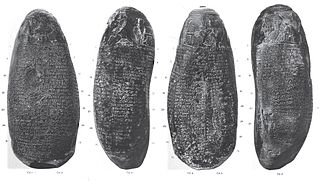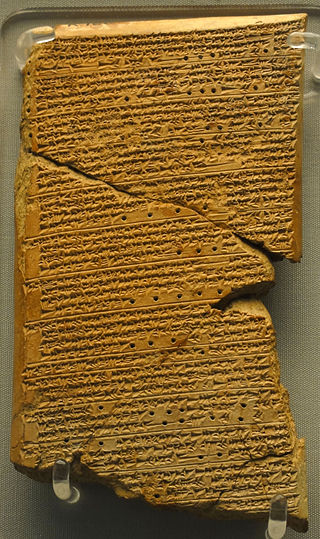Related Research Articles
Sippar was an ancient Near Eastern Sumerian and later Babylonian city on the east bank of the Euphrates river. Its tell is located at the site of modern Tell Abu Habbah near Yusufiyah in Iraq's Baghdad Governorate, some 69 km (43 mi) north of Babylon and 30 km (19 mi) southwest of Baghdad. The city's ancient name, Sippar, could also refer to its sister city, Sippar-Amnanum ; a more specific designation for the city here referred to as Sippar was Sippar-Yahrurum.

Shamash was the ancient Mesopotamian sun god, also known as Utu. He was believed to see everything that happened in the world every day, and was therefore responsible for justice and protection of travelers. As a divine judge, he could be associated with the underworld. Additionally, he could serve as the god of divination, typically alongside the weather god Adad. While he was universally regarded as one of the primary gods, he was particularly venerated in Sippar and Larsa.The moon god Nanna (Sin) and his wife Ningal were regarded as his parents, while his twin sister was Inanna (Ishtar). Occasionally other goddesses, such as Manzat and Pinikir, could be regarded as his sisters too. The dawn goddess Aya (Sherida) was his wife, and multiple texts describe their daily reunions taking place on a mountain where the sun was believed to set. Among their children were Kittum, the personification of truth, dream deities such as Mamu, as well as the god Ishum. Utu's name could be used to write the names of many foreign solar deities logographically. The connection between him and the Hurrian solar god Shimige is particularly well attested, and the latter could be associated with Aya as well.

Damgalnuna, also known as Damkina, was a Mesopotamian goddess regarded as the wife of the god Enki. Her character is poorly defined in known sources, though it is known that like her husband she was associated with ritual purification and that she was believed to intercede with him on behalf of supplicants. Among the deities regarded as their children were Nanshe and Asalluhi. While the myth Enki and Ninhursag treats her as interchangeable with the goddess mentioned in its title, they were usually separate from each other. The cities of Eridu and Malgium were regarded as Damgalnuna's cult centers. She was also worshiped in other settlements, such as Nippur, Sippar and Kalhu, and possibly as early as in the third millennium BCE was incorporated into the Hurrian pantheon. She appears in a number of myths, including the Enūma Eliš, though only a single composition, Damkina's Bond, is focused on her.

Babylonian religion is the religious practice of Babylonia. Babylonia's mythology was greatly influenced by its Sumerian counterparts and was written on clay tablets inscribed with the cuneiform script derived from Sumerian cuneiform. The myths were usually either written in Sumerian or Akkadian. Some Babylonian texts were translations into Akkadian from Sumerian of earlier texts, but the names of some deities were changed.

Zarpanitu was a Mesopotamian goddess regarded as the spouse of Marduk. Not much is known about her character, though late sources indicate that she was associated with pregnancy and that she could be assigned similar roles as her husband, including that of queen of the gods. She was originally worshiped in Zarpan, a village near Babylon, though the latter city itself also served as her cult center.

Nanaya was a Mesopotamian goddess of love closely associated with Inanna.
Aya was a Mesopotamian goddess associated with dawn. Multiple variant names were attributed to her in god lists. She was regarded as the wife of Shamash, the sun god. She was worshiped alongside her husband in Sippar. Multiple royal inscriptions pertaining to this city mention her. She was also associated with the Nadītu community inhabiting it. She is less well attested in the other cult center of Shamash, Larsa, though she was venerated there as well. Additional attestations are available from Uruk, Mari and Assur. Aya was also incorporated into Hurrian religion, and in this context she appears as the wife of Shamash's counterpart Šimige.
Gibil (𒀭𒉈𒄀), also known under the Akkadian name Girra, was a Mesopotamian god associated with fire, both in its positive and negative aspects. He also played a role in ritual purification. Textual sources indicate his symbol was a torch, though no representations of him have been identified in Mesopotamian art. Multiple genealogies could be assigned to him. The god list An = Anum indicates his spouse was Ninirigal. He was also frequently associated with deities such as Shamash, Nuska and Kusu. He is first attested in Early Dynastic texts from Shuruppak, such as offering lists. He was also a member of the pantheon of Eridu. In the Kassite period he was worshiped in Nippur. Later attestations are available from Assyria and from Uruk. He also appears in a number of literary texts.
Tashmetum was a Mesopotamian goddess. Her character is poorly understood, and she is best attested as the spouse of Nabu, though they only came to be associated with each other in the eighteenth century BCE. She was worshiped in Assyria as early as in the nineteenth century BCE, and reached Babylonia in the Old Babylonian period. Sources from the first millennium BCE indicate she was venerated alongside Nabu in cities such as Borsippa and Kalhu.
Tell al-Lahm is an archaeological site in Dhi Qar Governorate (Iraq). It is 38 km (24 mi) southeast of the site of ancient Ur. Its ancient name is not known with certainty with Kuara, Kisig, and Dur-Iakin having been proposed. The Euphrates River is 256 km (159 mi) away but in antiquity, or a branch of it, ran by the site, continuing to flow until the Muslim Era.

Nabû-apla-iddina, inscribed mdNábû-ápla-iddinana or mdNábû-apla-íddina; reigned about 886–853 BC, was the sixth king of the dynasty of E of Babylon and he reigned for at least thirty-two years. During much of Nabû-apla-iddina's reign Babylon faced a significant rival in Assyria under the rule of Ashurnasirpal II. Nabû-apla-iddina was able to avoid both outright war and significant loss of territory. There was some low level conflict, including a case where he sent a party of troops led by his brother to aid rebels in Suhu. Later in his reign Nabu-apla-iddina agreed to a treaty with Ashurnasirpal II’s successor Shalmaneser III. Internally Nabu-apla-iddina worked on the reconstruction of temples and something of a literary revival took place during his reign with many older works being recopied.

The Tablet of Shamash is a stele recovered from the ancient Babylonian city of Sippar in southern Iraq in 1881; it is now a major piece in the British Museum's ancient Middle East collection and is a visual attestation of Babylonian cosmology. It is dated to the reign of King Nabu-apla-iddina ca. 888 – 855 BC.
Adad-apla-iddina, typically inscribed in cuneiform mdIM-DUMU.UŠ-SUM-na, mdIM-A-SUM-na or dIM-ap-lam-i-din-[nam] meaning the storm god “Adad has given me an heir”, was the 8th king of the 2nd Dynasty of Isin and the 4th Dynasty of Babylon and ruled c. 1064–1043. He was a contemporary of the Assyrian King Aššur-bêl-kala and his reign was a golden age for scholarship.
Simbar-Šipak, or perhaps Simbar-Šiḫu, was a Babylonian king who reigned c. 1021–1004 BC.

The Land grant to Munnabittu kudurru is an elongated egg-shaped black limestone ancient Mesopotamian narû or entitlement stele (kudurru), 46.5 cm high and 20.5 cm wide, which details the reconfirmation of a gift of 30 GUR of land by Kassite king Marduk-apla-iddina I to his servant Munnabittu, son of Ṭābu-melû. It is significant because, in addition to portraying eighteen divine icons around its top, it lists forty-seven gods in its inscription, more than any other similar object.

Ninsianna was a Mesopotamian deity considered to be the personification of Venus. This theonym also served as the name of the planet in astronomical texts until the end of the Old Babylonian period. There is evidence that Ninsianna's gender varied between locations, and both feminine and masculine forms of this deity were worshiped. Due to their shared connection to Venus, Ninsianna was associated with Inanna. Furthermore, the deity Kabta appears alongside Ninsianna in many texts, but the character of the relation between them remains unclear.

The Babylonian revolts of 484 BC were revolts of two rebel kings of Babylon, Bel-shimanni and Shamash-eriba, against Xerxes I, king of the Persian Achaemenid Empire.

Annunitum was a Mesopotamian goddess associated with warfare. She was initially an epithet of Ishtar of Akkad exemplifying her warlike aspect, but by the late third millennium BCE she came to function as a distinct deity. She was the tutelary goddess of the cities of Akkad and Sippar-Amnanum, though she was also worshiped elsewhere in Mesopotamia.
Mār-bīti was a Mesopotamian god. While his character is overall poorly known, it is agreed that he was regarded as warlike. He could be associated with deities such as Nanaya, Nabu or various members of the local pantheons of Der and Borsippa. While he is already attested in an inscription from the Kassite period, most attestations of him come from the first millennium BCE. He was originally worshiped in Malgium and Der in eastern Mesopotamia, but he is also attested in Borsippa, Babylon and Kalhu. A number of temples dedicated to him are mentioned in known texts, but their ceremonial names in most cases remain unknown. Two kings of Babylonia bore theophoric names invoking him, Mār-bīti-apla-uṣur and Mār-bῑti-aḫḫē-idinna.
Kusibanda (Kusigbanda), also known under the disputed older reading of the name, Guškinbanda, was a Mesopotamian god regarded as the tutelary deity of goldsmiths and silversmiths. He was commonly grouped with other deities of similar character, such as Ninagal. He was also regarded as the husband of Ninimma, and was worshiped in her temple in Nippur. He is attested in texts describing the preparation of statues, as well as in a variety of documents from Uruk from the Seleucid period.
References
- ↑ Jeremy Black; Graham Cunningham; Eleanor Robson; Gábor Zólyomi (2006). The Literature of Ancient Sumer. Oxford University Press. p. 126.
- ↑ A. R. George (1993). House Most High: The Temples of Ancient Mesopotamia . Eisenbrauns. p. 118.
- ↑ Paul-Alain Beaulieu (2003). The Pantheon of Uruk During the Neo-Babylonian Period. Brill. p. 371.
- ↑ A. Leo Oppenheim (1969). "Babylonian and Assyrian Historical Texts". In James B. Pritchard (ed.). Ancient Near Eastern Texts Relating to the Old Testament (ANET) 3rd Edition with Supplement. Princeton University Press. p. 557.
- ↑ Jennie Myers (2002). The Sippar Pantheon: A Diachronic Study (Harvard thesis). unpublished. pp. 78–79.
- ↑ Christopher E. Woods (2004). "The Sun-God Tablet of Nabû-apla-iddina Revisited". Journal of Cuneiform Studies: 37, 43.
- ↑ Ira Spar, Michael Jursa (2014). Cuneiform Texts in the Metropolitan Museum of Art: Volume IV: The Ebabbar Temple Archive. Metropolitan Museum of Art. pp. 76–83.